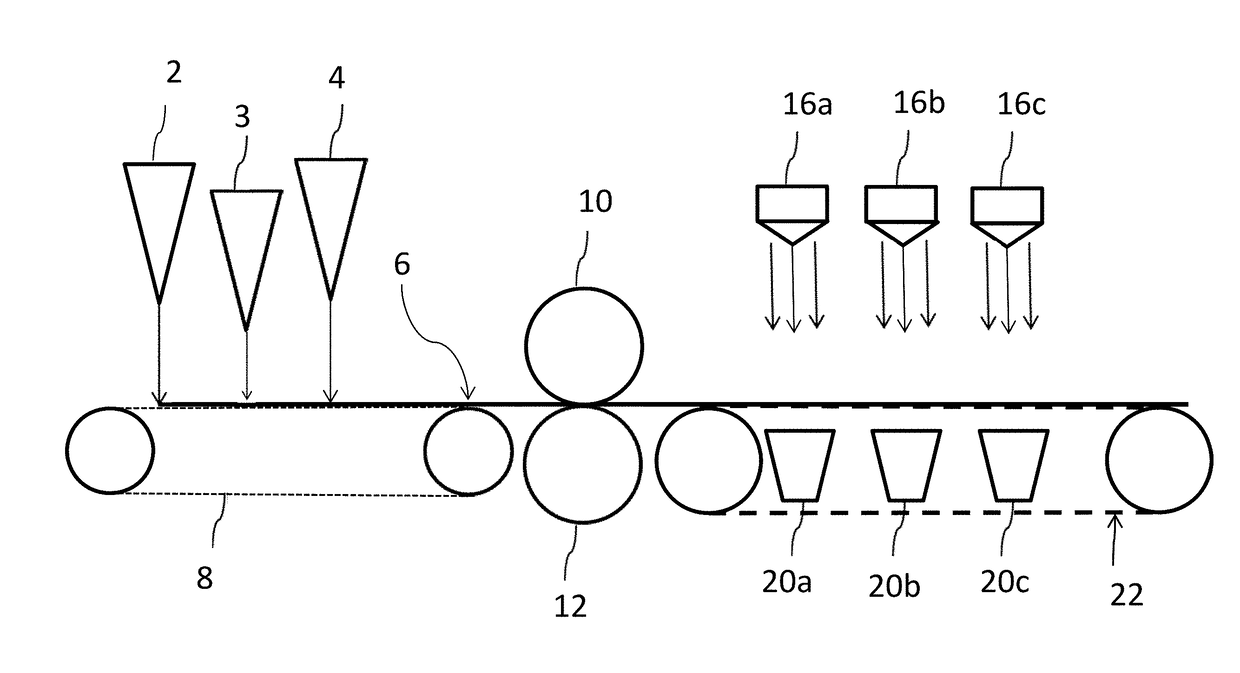Multi-denier hydraulically treated nonwoven fabrics and method of making the same
- Summary
- Abstract
- Description
- Claims
- Application Information
AI Technical Summary
Benefits of technology
Problems solved by technology
Method used
Image
Examples
example 1
[0075]The nonwoven fabric of Example 1 was produced by calendering 4 layers of spunbond and then hydroengorging the laminate followed by drying and winding. Each spunbond layer was made up of approximately 77% CP 360H Braskem polypropylene resin, 20% Vistamaxx 7020-BF from Exxon-Mobil and 3% polypropylene masterbatch resin from Standridge Color Corporation containing 10% TiO2 and 10% Erucamide slip aid by weight respectively. During spinning of each spunbond layer, the filaments were spun at a throughput of about 112 kg / hr / m and exposed to cabin pressures in the range of about 4000 Pascals. These layers were calendered with an engraved roll temperature of 165° C., smooth roll temperature of 167° C. and a pressure between the engraved and smooth roll in the range of 67 N / mm. This calendered web was subsequently hydrogorged in 2 steps with each step comprised of a HE drum and 2 injectors. The calendered fabric was exposed to HE pressure ranges of 140 bars of water pressure per injecto...
example 2
[0076]The nonwoven fabric of Example 2 was produced by calendering 4 layers of spunbond and then hydroengorging the laminate followed by drying and winding. Each spunbond layer was made up of approximately 77% CP 360H Braskem polypropylene resin, 5% 3962 Meltblown PP resin from Total Petrochemicals, 15% Vistamaxx 7020-BF from Exxon-Mobil and 3% polypropylene masterbatch resin from Standridge Color Corporation containing 10% TiO2 and 10% Erucamide slip aid by weight respectively. During spinning of each spunbond layer, the filaments were spun at a throughput of about 112 kg / hr / m and exposed to cabin pressures in the range of about 4000 Pascals. These layers were calendered with an engraved roll temperature of 165° C., smooth roll temperature of 167° C. and a pressure between the engraved and smooth roll in the range of 67 N / mm. This calendered web was subsequently hydroengorged in 2 steps with each step comprised of a HE drum and 2 injectors. The calendered fabric was exposed to HE p...
example 3
[0077]The nonwoven fabric of Example 3 was produced by calendering 4 layers of spunbond and then hydroengorging the laminate followed by drying and winding. Each spunbond layer was made up of approximately 82% CP 360H Braskem polypropylene resin, 5% 3962 Meltblown PP resin from Total Petrochemicals, 10% Vistamaxx 7020-BF from Exxon-Mobil and 5% polypropylene masterbatch resin from Standridge Color Corporation containing 10% TiO2 and 10% Erucamide slip aid by weight respectively. During spinning of each spunbond layer, the filaments were spun at a throughput of about 112 kg / hr / m and exposed to cabin pressures in the range of about 4000 Pascals. These layers were calendered with an engraved roll temperature of 165° C., smooth roll temperature of 167° C. and a pressure between the engraved and smooth roll in the range of 67 N / mm. This calendered web was subsequently hydroengorged in 2 steps with each step comprising of a HE drum and 2 injectors. The calendered fabric was exposed to HE ...
PUM
| Property | Measurement | Unit |
|---|---|---|
| Fraction | aaaaa | aaaaa |
| Fraction | aaaaa | aaaaa |
| Percent by mass | aaaaa | aaaaa |
Abstract
Description
Claims
Application Information
 Login to View More
Login to View More - R&D Engineer
- R&D Manager
- IP Professional
- Industry Leading Data Capabilities
- Powerful AI technology
- Patent DNA Extraction
Browse by: Latest US Patents, China's latest patents, Technical Efficacy Thesaurus, Application Domain, Technology Topic, Popular Technical Reports.
© 2024 PatSnap. All rights reserved.Legal|Privacy policy|Modern Slavery Act Transparency Statement|Sitemap|About US| Contact US: help@patsnap.com










